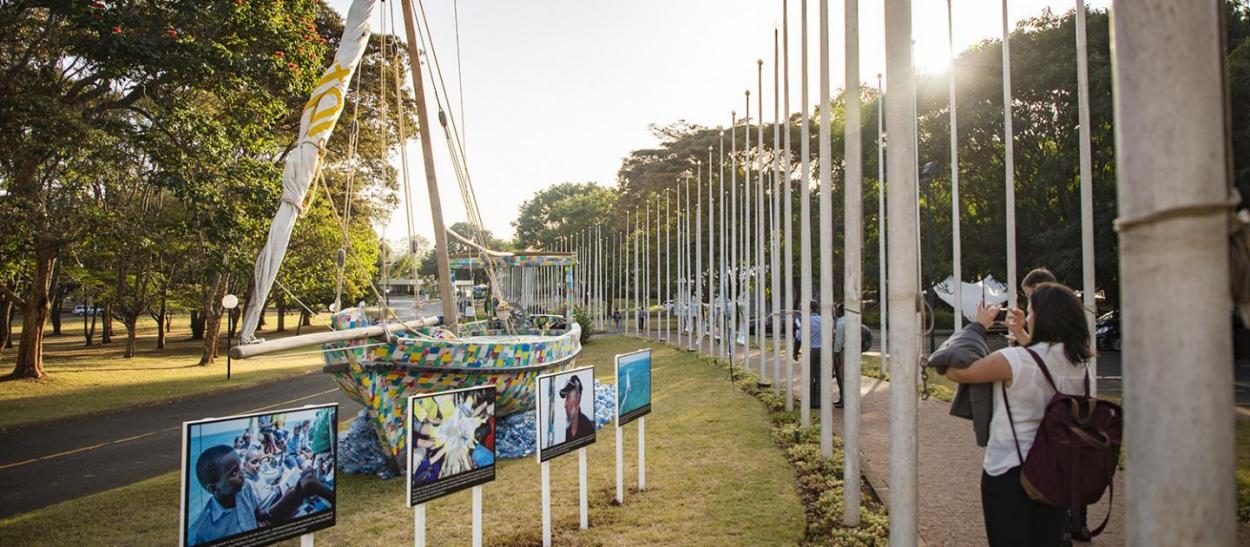
As delegates made their way into the UN Environmental summit in Nairobi this week, many were pulled up short by the sight of a rainbow-hued traditional dhow boat resting serenely on the grass.
“Is this the boat that was on the news? Can it sail?” one delegate asked as he hopped over a flowerbed to run his hands along the multicoloured sides of the Flipflopi, the first dhow made entirely of recycled plastic, and an icon of African creativity and innovation.
If anything could encapsulate the aims of the Fourth UN Environment Assembly, it might be the Flipflopi. As environment ministers and officials arrived to begin five days of talks on how to save our planet by transforming our lives, they passed this trailblazing tribute to the power of conviction, collaboration and a no-nonsense commitment to action.
Built from 10 tonnes of plastic trash picked up from Kenyan beaches and roads, and around 30,000 repurposed flip flops, the nine-metre-long Flipflopi sailed more than 500 km from the idyllic island of Lamu, down Kenya’s Indian Ocean coast and on to Zanzibar earlier this year to spread a plastic revolution by inspiring people to reduce their use of throwaway plastic and recycle whatever they could.

Photo by UN Environment
The sprightly little boat became something of a shipshape superstar, drawing crowds and media coverage at every stop. The expedition was supported by UN Environment’s Clean Seas campaign, which has been working since 2017 to urge governments, businesses and citizens to eliminate single-use plastics.
Now the Flipflopi team want to take their plastic revolution even further, by building a bigger boat and sailing it down to South Africa, and beyond.
“We want to take this African plastic revolution to the rest of the world and showcase that spirit of innovation and creativity that exists on our soil. Africa has something to offer,” said Dipesh Pabari, Kenyan entrepreneur and Flipflopi project leader, who was on board the dhow on Monday, ready to answer questions, inspire delegates and hopefully find some willing backers.
Pabari, alongside tour operator Ben Morison and boat builder Ali Skanda, led the team of volunteers who brought the Flipflopi dream to life, but he never thought the inaugural voyage to Zanzibar would be so successful.
“It was beyond our expectations,” he said. “When you’ve lived and breathed something for so long, after a while you start to think that you are the only one who’s so insane and inspired by it. To see droves of people coming out, children, county government officials, tourists, everyone, it was really magical. We always wanted this to be everybody’s story.”
Along the way, the Flipflopi stopped at towns and cities to organize recycling workshops, educate communities about how to cut down on plastic and also learn about the work of other environmentalists. Pabari and his team were determined to highlight the work of local conservationists and activists as part of their campaign.
After the voyage, the Flipflopi was hoisted onto a truck and brought to Nairobi to take pride of place at the summit. But this is not the end of the voyage for Pabari.
“For people to see her now in the flesh, and to know that she sailed 500 km and back untouched, I’m hoping this will inspire other innovations and also that people will be less sceptical in joining us to make a boat twice the size. We want to make a boat that’s capable of sailing to South Africa and beyond.”
Pabari estimates they would need around US$1.5 million to do this. He hopes industry might be persuaded to support the project and, more importantly, also galvanized to change their policies around plastic waste.
“We want people to actually commit to action, making stronger policy and enforcement changes within their own industries. We’re not pointing the finger at industries—we’re all end users—but they do have a moral responsibility to clean up their mess, or help the rest of us clean it up. The boat is an opportunity for people to have a positive symbol of hope and change, and to get behind something that’s real and tangible,” he said.
The kind of innovative thinking that lies behind the Flipflopi is at the heart of the UN Environment Assembly, which revolves around seeking innovative solutions for environmental challenges and promoting sustainable consumption and production.
Opening the discussions on Monday, UN Environment’s Acting Executive Director Joyce Msuya said the world could no longer grow now and clean up later.
“It is clear that we need to transform the way we live, how we produce and the choices we make. We have grown at the expense of nature and it is time to take a 360-degree U-turn,” she told delegates, describing innovation as the “heartbeat of the transformation we want”.
For Pabari, the Flipflopi is a perfect example of the potential of such innovation.
“We’re all just average citizens. We’ve demonstrated that something that was seen as impossible can be done, so imagine if you had the real brains and money behind this?”
In the meantime, the Flipflopi’s adventures are by no means over. After the summit, she will return to the coast, where the team hope to take to the sea again when the winds change in April, ready to work mindset miracles wherever they go.
“She will continue sailing and spreading that message that we have to end [consuming] single-use plastics,” Pabari said. “When people are sitting in the boat, and you say, ‘this is made from toothbrushes and bottles,’ and they say, ‘what, how, when?’ that’s when the real story begins.”
At the United Nations Environment Assembly this week, UN Environment is urging people to Think Beyond and Live Within. Join the debate on social media using #SolveDifferent to share your stories and see what others are doing towards a sustainable future for our planet.
Related Sustainable Development Goals
Goal 12
Sustainable Consumption and Production
